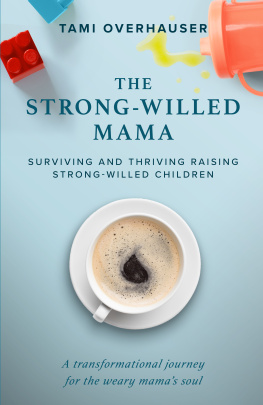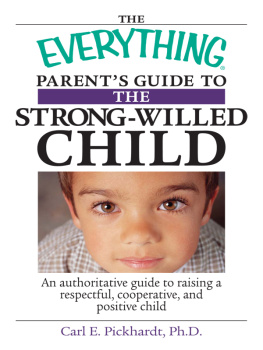The New Strong-Willed Child

A completely revised and rewritten guide
taking you from birth through adolescence
DR. JAMES DOBSONA

Visit Tyndales exciting Web site at www.tyndale.com.
TYNDALE and Tyndales quill logo are registered trademarks of Tyndale House Publishers, Inc.
The New Strong-Willed Child
This book is a completely revised edition of The Strong-Willed Child, first published in 1978 by Tyndale House Publishers, Inc.
Copyright 1978, 2004 by James Dobson, Inc. All rights reserved.
Author photograph copyright 1997 by Harry Langdon. All rights reserved.
Designed by Erik M. Peterson
All Scripture permissions, unless otherwise indicated, are taken from the Holy Bible, New International Version,NIV . Copyright 1973, 1978, 1984 by Biblica, Inc. Used by permission of Zondervan. All rights reserved worldwide.
Scripture quotations marked KJV are taken from the Holy Bible, King James Version.
Scripture verses marked Phillips are taken from The New Testament in Modern English by J. B. Phillips, copyright J. B. Phillips, 1958, 1959, 1960, 1972. All rights reserved.
Scripture quotations marked RSV are taken from the Revised Standard Version of the Bible, copyright 1952 [2nd edition, 1971] by the Division of Christian Education of the National Council of the Churches of Christ in the United States of America. Used by permission. All rights reserved.
Library of Congress Cataloging-in-Publication Data
Dobson, James C., date.
The new strong-willed child : birth through adolescence / James C. Dobson.
p. cm.
Rev. ed. of: The strong-willed child, 1978.
Includes bibliographical references.
ISBN 978-0-8423-3622-2 (hc) ISBN 978-1-4143-1363-4 (sc)
1. Child rearing. 2. Discipline of children. 3. Child psychology. I. Dobson, James C., date. Strong-willed child. II. Title
HQ772.D58 2004
649'.1dc22
2004005986
ISBN 978-1-4143-0281-2 (International Edition)
Printed in the United States of America
15 14 13 12 11 10
10 9 8 7 6 5
THIS BOOK IS AFFECTIONATELY DEDICATED TO MY OWN LATE MOTHER, who was blessed with a brilliant understanding of children. She intuitively grasped the meaning of discipline and taught me many of the principles Ive described on the following pages. And, of course, she did an incredible job raising me, as everyone can plainly see today. But Ive always been puzzled by one troubling question: Why did my fearless mother become such a permissive pushover the moment we made her a grandmother?
CONTENTS
I N 1978, when the first edition of The Strong-Willed Child was published, I had recently made a dramatic career move. I had resigned from the faculty of the University of Southern California School of Medicine where I had been an associate clinical professor of pediatrics for a number of years. My decision to leave this rewarding position resulted from an increasing awareness that the institution of the family was rapidly deterioratingand that I needed to do what I could to help. Thus, I left my secure nest to create a humble little nonprofit outfit called Focus on the Family and began a radio program heard initially on thirty-four stations. Frankly, I wondered if the phone would ever ring.
More than 30 years later, the radio program and its derivatives are heard by 220 million people each day on 7,300 radio stations located in 160 countries around the world. The staff consists of 850 members, who are also committed to the preservation of the family. Upwards of 200,000 listeners and readers call or write to us each month, many of whom are asking questions about how to raise healthy, well-adjusted kids. Today, when I meet these moms and dads whose lives we have touched through the years, some of them smile and tell me stories about their children, some hug me, and some get teary eyed. Many will say, Thank you for helping me raise my kids. Being able to assist these special folks through the child-rearing years has provided one of the greatest satisfactions of my life, both personally and professionally.
One of the first writing projects I tackled after leaving academia in 1977 was the original version of the book you hold. As the title indicates, it focused on the basic temperaments of boys and girls and what influences them to do what they do. Of particular interest to me is a characteristic I call the strength of the will. Some kids seem to be born with an easygoing, compliant nature that makes them a joy to raise. As infants they dont cry very often; they sleep through the night from the second week; they goo at their grandparents; they smile while being diapered; and they are very patient when dinner is overdue. And, of course, they never spit up on the way to church. During later childhood, they love to keep their room clean and they especially like doing their homework. There arent many of these supercompliant children, Im afraid, but they are known to exist in some households (though they didnt in ours).
Just as surely as some children are naturally compliant, others seem to be defiant upon exit from the womb. They come into the world smoking a cigar and yelling about the temperature in the delivery room and the incompetence of the nursing staff and the way the doctors are running things. Long before their children are born, mothers of strong-willed children know there is something different going on inside, because their babies have been trying to carve their initials on the walls. In infancy, these children fairly bristle when their bottle is late and demand to be held throughout the day. Three oclock in the morning is their favorite playtime. Later, during toddlerhood, they resist all forms of authority and their greatest delights include painting the carpet with Moms makeup or trying to flush the family cat down the toilet. Their frustrated parents wonder where they went wrong and why their child-rearing experience is so different from what they had expected. They desperately need a little coaching about what to do next.
That was the basic premise of my book back in 1978. But the years since then have passed very quickly, and the tough-as-nails kids about whom I was writing are now grown, having made the breathless journey from babyhood to adolescence and on into adulthood. Most of them now have strong-willed children of their own, which is rather humorous to contemplate. As kids, they gave their parents fits, but now the chickens have come home to roost. These new moms and dads are getting their just desserts, and they deserve everything their kids are doing to rattle their nerves. Their parents, to whom I addressed the original book, are likely to be grandparents now who have probably evolved into permissive pushovers just as my marvelous mom did when we made her a grandmother. And so the cycle of life continues, generation by generation, with each family member playing a prearranged part that feels entirely new, but which is actually rooted in antiquity.
It is with relish, therefore, that I return to this subject, which has been a lifelong fascination. Nearly 3 million copies of The Strong-Willed Child have sold in dozens of languages, but it became clear to me recently that the time had come to revise the manuscript. A wealth of new information has come to light since I first put my thoughts on paper (yes, on paperI wrote the original manuscript with pencils on yellow pads, resulting in sheets that were taped together to produce a scroll that sometimes exceeded fifty feet. Inexplicably, I didnt get into the computer thing until the twentieth century was almost over).
Next page










